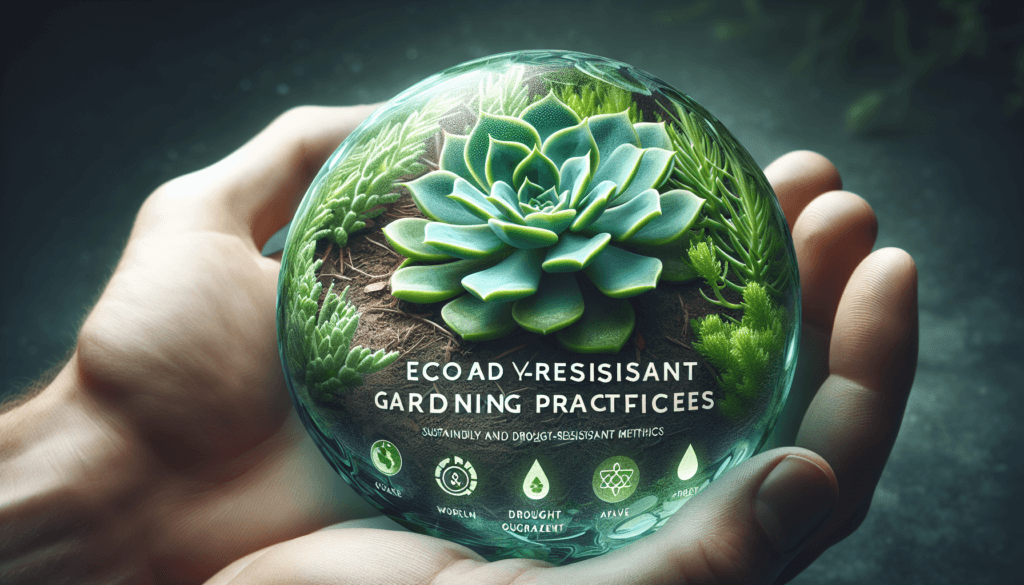Are you a gardening enthusiast looking for eco-friendly solutions to maintain a lush and vibrant garden even during drought conditions? Look no further! In this article, we will explore some creative and sustainable techniques that you can incorporate into your gardening routine to ensure the health and resilience of your plants while conserving water. From smart irrigation systems to mulching and rainwater harvesting, we’ve got you covered with practical tips and innovative ideas to help you create a stunning garden that thrives even in the driest of times. Let’s get started on our journey towards drought-resistant gardening together!
Selecting Drought-Resistant Plants
Understanding the climate and soil conditions
Before selecting plants for your garden, it is essential to understand the climatic conditions of your region and the soil type in your garden. Different plants have varying preferences when it comes to temperature, humidity, and soil conditions. By understanding your climate and soil, you can choose plants that are better adapted to thrive in these conditions, making them more drought-resistant.
Researching native plants
One of the most effective ways to ensure the success of your garden is to choose native plants. Native plants have evolved to adapt to the local climate, soil conditions, and the ecological balance of your area. They have developed natural mechanisms to survive periods of drought and require less water and maintenance compared to non-native species. Researching and selecting native plants will not only save water but also support the local ecosystem and biodiversity.
Choosing drought-tolerant varieties
Another approach to selecting drought-resistant plants is to look for drought-tolerant varieties. These are plant species or cultivars that have been specifically bred or selected for their ability to withstand dry conditions. These plants have developed adaptations such as deep root systems, water-storing tissues, or waxy leaves to minimize water loss. By choosing drought-tolerant varieties, you can create a beautiful garden that requires less water and maintenance.
Considering succulents and cacti
Succulents and cacti are excellent choices for drought-resistant gardening. These plants have thick, fleshy leaves or stems that store water, allowing them to survive in dry conditions. They come in a wide variety of shapes, sizes, and colors, making them perfect for adding texture and visual interest to your garden. Whether you prefer the vibrant hues of Echeverias or the spiky elegance of Agaves, succulents and cacti can thrive in both indoor and outdoor spaces with minimal water requirements.
Exploring Mediterranean or desert plants
If you are looking for plants that are well-suited for drought resistance, exploring Mediterranean or desert plants is a great idea. These plants have adapted to thrive in regions with hot, dry summers and mild, wet winters. Olive trees, lavender, rosemary, and yuccas are just a few examples of Mediterranean and desert plants that can add a touch of exotic beauty to your garden while conserving water.
Water Conservation Techniques
Collecting and utilizing rainwater
One of the most eco-friendly ways to conserve water in your garden is by collecting and utilizing rainwater. Install rain barrels or cisterns to capture rainwater from your roof or other surfaces. This water can then be used for watering your plants, reducing your reliance on municipal water sources. It is important to ensure that the rainwater is collected and stored in a clean and safe manner, away from potential contaminants.
Installing drip irrigation systems
Drip irrigation systems are a highly efficient way to deliver water directly to the roots of plants, minimizing waste through evaporation and runoff. These systems consist of tubes or pipes with small holes or emitters that slowly release water close to the base of each plant. By delivering water directly to the root zone, drip irrigation systems provide plants with the moisture they need while reducing water loss.
Using mulch to retain moisture
Mulching is a simple but effective technique for conserving soil moisture. By applying a layer of organic mulch, such as wood chips or straw, around your plants, you can reduce evaporation and suppress weed growth. Mulch acts as a protective barrier, keeping the soil temperature cooler and preventing moisture loss from the soil surface. Additionally, as the mulch breaks down, it adds organic matter to the soil, improving its water-holding capacity.
Grouping plants with similar water needs
A smart water conservation technique is to group plants with similar water needs together in your garden. By clustering plants that have similar moisture requirements, you can create microclimates within your garden, making it easier to water them efficiently. For example, group water-loving plants together in an area where they can receive more frequent watering, while drought-tolerant plants can be grouped in a separate area with less frequent watering.
Implementing xeriscaping techniques
Xeriscaping is a landscaping approach that focuses on water conservation and drought-resistant plants. By designating areas of your garden for low-water use plants, minimizing turf grass, and incorporating natural elements like rocks and gravel, you can create a beautiful and sustainable landscape. Xeriscaping reduces water requirements, maintenance, and the need for irrigation, making it a practical choice for drought-resistant gardening.

Soil Preparation and Maintenance
Improving soil structure and drainage
Preparing your soil before planting is crucial for the health and success of your garden, especially in drought-prone areas. You can improve soil structure and drainage by adding organic matter like compost, which helps to loosen clay soils and increase water-holding capacity in sandy soils. This allows for better root growth and water infiltration, reducing the risk of water runoff and enhancing the plants’ ability to access moisture.
Adding organic matter and compost
Organic matter and compost are essential for maintaining healthy soil. They improve the soil’s ability to retain moisture, provide necessary nutrients to plants, and enhance beneficial soil microorganisms. By adding compost or well-rotted organic matter to your garden beds regularly, you are ensuring that the soil remains fertile and moisture-rich, even during dry periods.
Using cover crops to prevent soil erosion
Cover crops, also known as green manures, are plants that are grown specifically to cover and protect the soil. They help prevent soil erosion by reducing water runoff and acting as a barrier against wind and rain. Cover crops also add organic matter to the soil when they are incorporated or mulched, improving its structure and moisture retention.
Mulching soil to inhibit weed growth
In addition to its moisture-retaining benefits, mulch also helps inhibit weed growth. Weeds compete with your plants for water and nutrients, and removing them can be time-consuming and costly. By mulching your garden beds with a layer of organic mulch, you create a weed-suppressing barrier that reduces the need for manual weeding while conserving moisture in the soil.
Regularly testing soil pH and nutrient levels
Regularly testing your soil’s pH and nutrient levels is essential for maintaining a healthy garden. Different plants have specific pH and nutrient requirements, and knowing your soil’s composition can help you make informed decisions about which plants to choose and what amendments to make. Soil testing kits are available at garden centers or through local agricultural extension services and can provide valuable insights into your soil’s health.
Smart Irrigation Practices
Watering during the coolest parts of the day
Watering your plants during the coolest parts of the day, such as early morning or late evening, can help minimize evaporation and ensure that the water reaches the plants’ roots efficiently. Avoid watering during the hottest parts of the day when evaporation rates are highest, as this can lead to water waste and less effective irrigation.
Adjusting watering frequency based on weather conditions
Watering frequency should be adjusted based on current weather conditions. During periods of rainfall or high humidity, plants may require less frequent watering. By observing the weather patterns in your area and monitoring soil moisture levels, you can tailor your watering schedule to meet the specific needs of your plants and avoid overwatering.
Performing deep watering to encourage deep root growth
Deep watering encourages plants to develop deep root systems, making them more resilient to drought conditions. Instead of frequent shallow watering, focus on providing a thorough soak to penetrate the soil deeply. This allows the plants to access water from further down in the soil, reducing their dependence on surface moisture and making them better equipped to withstand dry spells.
Avoiding water runoff and evaporation
When watering your plants, it is important to avoid water runoff and evaporation to reduce water waste. To prevent runoff, water your plants slowly and evenly, allowing time for the soil to absorb the moisture. Consider using techniques like drip irrigation or soaker hoses that deliver water directly to the roots. Additionally, avoid watering foliage or paved areas, as this can result in unnecessary evaporation.
Utilizing smart irrigation controllers
Smart irrigation controllers use weather data, soil moisture sensors, and programmed schedules to automatically adjust watering based on real-time conditions. These controllers can save water by preventing overwatering and adjusting irrigation amounts based on specific plant needs. With advancements in technology, smart irrigation systems are becoming more affordable and user-friendly, making them a valuable tool for eco-conscious gardeners.

Planting and Garden Design Tips
Arranging plants according to their water needs
When planning your garden layout, consider arranging plants according to their water needs. As mentioned earlier, grouping plants with similar water requirements together can simplify watering and make it more efficient. Additionally, placing water-loving plants near a water source can reduce the length of irrigation lines and minimize the loss of water through transportation.
Creating shade and wind barriers
Creating shade and wind barriers in your garden can help reduce water loss through evaporation and protect plants from drying winds. Strategically planting trees, shrubs, or trellises can provide shade for more delicate plants or create microclimates that retain moisture. Wind barriers, such as hedges or fences, can shield plants from strong winds, which can accelerate water evaporation from leaves and soil.
Growing plants in raised beds or containers
Growing plants in raised beds or containers offers several advantages for drought-resistant gardening. These elevated gardening spaces allow for better control over soil moisture levels and drainage. The soil in raised beds and containers tends to warm up faster, which can promote root growth and efficient water uptake. In addition, containers provide the flexibility to move plants around based on their sun and water requirements.
Using trellises and vertical gardening techniques
Trellises and vertical gardening techniques maximize the use of space in your garden and can provide shading for other plants. By training climbing plants such as vines or peas to grow vertically, you can create a vertical garden that conserves water and increases planting options. Additionally, the shade created by the vertical growth can help keep the soil cool and reduce moisture loss.
Incorporating permeable paving materials
In areas where hardscaping is necessary, such as driveways or walkways, consider incorporating permeable paving materials. Permeable pavers allow rainwater to infiltrate the soil instead of running off into storm drains. This helps replenish groundwater and reduces the need for additional irrigation. Permeable paving also prevents heat buildup, minimizing water evaporation from the surrounding soil.
Companion Planting and Natural Pest Control
Pairing plants with complementary characteristics
Companion planting involves strategically placing plants that have mutually beneficial relationships. Some plants repel pests, while others attract beneficial insects or enrich the soil. For example, planting marigolds near tomatoes can deter nematodes, and growing basil alongside beans can enhance their growth. By choosing plant combinations that work well together, you can minimize the use of chemical pesticides and create a balanced ecosystem in your garden.
Attracting beneficial insects and birds
Encouraging beneficial insects and birds is a natural and eco-friendly form of pest control. Ladybugs, lacewings, and certain bird species, such as swallows or bluebirds, feed on garden pests like aphids or caterpillars. To attract these helpful creatures, include plants that produce nectar, pollen, or berries in your garden. Providing bird feeders, bird baths, or nesting boxes can also create a welcoming environment for beneficial wildlife.
Implementing integrated pest management techniques
Integrated pest management (IPM) is an approach that combines preventive cultural practices, biological controls, and minimal pesticide use to manage pests effectively. By regularly inspecting your plants for signs of pests or disease, identifying the specific problem, and implementing appropriate control measures, you can reduce the need for chemical interventions and promote a healthier garden ecosystem.
Creating wildlife-friendly habitats
Expanding your focus beyond plants, consider creating wildlife-friendly habitats in your garden. Include features like birdhouses, water sources, or butterfly gardens to attract a diverse range of wildlife. By supporting biodiversity and providing natural habitats, you can encourage the presence of beneficial insects and other wildlife that contribute to a balanced ecosystem and help control pest populations.
Using organic pest control methods
When pests become a problem in your garden, opt for organic pest control methods before considering chemical solutions. There are various organic pest control options available, such as insecticidal soaps, neem oil, or homemade garlic spray. These natural remedies can be effective against common pests while minimizing harm to beneficial insects, pollinators, and the environment.

Efficient Fertilizer and Compost Usage
Applying slow-release organic fertilizers
When fertilizing your plants, choose slow-release organic fertilizers that provide a steady supply of nutrients over time. Slow-release fertilizers ensure that plants receive the nutrients they need without excess runoff, preventing water pollution. Organic fertilizers like composted manure, bone meal, or fish emulsion not only nourish your plants but also improve the soil’s structure and water-holding capacity.
Enriching soil with homemade compost
Compost is often referred to as “black gold” for gardeners due to its numerous benefits. By enriching your soil with homemade compost, you are supplementing it with organic matter, improving its nutrient content, water-holding capacity, and overall fertility. Compost also enhances microbial activity in the soil, contributing to healthier plant growth and reducing the need for synthetic fertilizers.
Using compost tea as a nutrient-rich fertilizer
Compost tea is a liquid fertilizer made by steeping compost in water. This nutrient-rich liquid can be applied directly to the soil or used as a foliar spray to provide plants with a boost of essential nutrients. Compost tea improves soil structure, stimulates microbial activity, and enhances plant growth. It is an effective way to recycle nutrients from compost and reduce dependence on synthetic fertilizers.
Avoiding chemical fertilizers and synthetic additives
In an eco-friendly drought-resistant garden, it is important to avoid chemical fertilizers and synthetic additives whenever possible. Synthetic fertilizers can leach into groundwater or surface water, causing pollution and disrupting the balance of ecosystems. Opt for organic and natural alternatives, which are not only safer for the environment but also promote long-term soil health and plant resilience.
Practicing proper composting techniques
Practicing proper composting techniques is essential for efficient compost production. Composting allows organic waste materials to decompose, creating nutrient-rich humus that can be used to amend soil. It is important to balance the carbon and nitrogen ratios, turn the compost regularly to promote aeration, and maintain the right moisture levels. By following these guidelines, you can produce high-quality compost that benefits your garden and reduces organic waste sent to landfills.
Managing Weeds Sustainably
Mulching to suppress weed growth
As previously mentioned, mulching is an effective method for conserving soil moisture, but it also helps suppress weed growth. A layer of organic mulch acts as a physical barrier, preventing weed seeds from germinating and competing with your plants. Mulching reduces the need for tedious hand-weeding and keeps soil moisture levels more balanced, creating a healthier garden environment.
Hand-pulling or using manual weeders
For selective weed removal, hand-pulling or using manual weeders can be an eco-friendly solution. By removing weeds manually, you have better control over which plants are removed and can minimize the disturbance of desirable plants. Regularly inspect your garden and promptly remove any unwanted weeds to prevent them from establishing and spreading.
Implementing weed barriers or landscape fabric
Weed barriers or landscape fabric can be used as an additional measure to suppress weed growth in specific areas of your garden. These materials are placed over the soil, preventing sunlight from reaching weed seeds and inhibiting their germination. Weed barriers are particularly useful in pathways, raised beds, or areas where you do not plan to grow plants directly in the soil.
Harnessing the power of solarization
Solarization is a method that utilizes the sun’s heat to kill weeds and unwanted plant matter. By covering the soil with a clear plastic sheet, solar energy heats the soil, reaching temperatures that are lethal to many weed seeds and seedlings. Solarization is most effective during warm, sunny periods and can help control persistent weeds or prepare a weed-free area before planting.
Utilizing natural weed control methods
Numerous natural weed control methods are effective and sustainable alternatives to chemical herbicides. For example, vinegar solutions can be used as a foliar spray to kill young weeds. Boiling water can be poured over weeds in areas where plants are not present, such as cracks in paving stones. It is important to remember that not all weeds can be eradicated completely, but by managing their growth, you can maintain a healthier garden ecosystem.

Sustainable Pest and Disease Management
Encouraging a diverse ecosystem to limit pest populations
Creating a diverse ecosystem in your garden can help limit pest populations naturally. By providing habitat and food sources for a variety of organisms, you encourage the presence of beneficial insects, birds, and other predators that feed on garden pests. Designing a garden that supports biodiversity helps establish a natural balance, keeping pest populations in check without the need for chemical interventions.
Inspecting plants regularly for signs of disease or pests
Regular inspections for signs of disease or pests are essential for early identification and prompt intervention. Checking your plants regularly allows you to notice any changes in foliage, flowers, or fruit that may indicate a problem. By catching pests or diseases early, you can take appropriate measures to prevent the issue from spreading and minimize the need for chemical treatments.
Using organic insecticidal soaps or oils
When pest problems arise, organic insecticidal soaps or oils can be effective alternatives to synthetic insecticides. These natural products suffocate soft-bodied pests like aphids or mites without causing harm to beneficial insects or the environment. They can be sprayed directly on affected plants, disrupting the pest’s life cycle and reducing the pest population.
Applying natural disease control methods
Natural disease control methods focus on preventing or managing diseases through cultural practices, plant selection, and organic treatments. Examples include providing adequate spacing between plants to improve air circulation, using disease-resistant varieties, removing infected plant material promptly, and applying natural fungicides like copper solutions or neem oil when necessary. Taking a proactive approach to disease management can help minimize the need for chemical interventions and promote healthier plants.
Practicing crop rotation and companion planting
Crop rotation and companion planting are ancient techniques that can be applied to manage pests and diseases sustainably. By rotating crops annually, you can disrupt pest life cycles and reduce the buildup of soil-borne diseases. Companion planting involves growing compatible plant species together to enhance pest resistance or attract beneficial insects. These techniques optimize the health and productivity of your garden while minimizing the need for chemical inputs.
Educating and Engaging the Community
Promoting local gardening and farming initiatives
One of the most impactful ways to promote sustainable gardening practices is by actively participating in local gardening and farming initiatives. Supporting community gardens, farmers’ markets, or local food cooperatives not only fosters a sense of community but also contributes to a more sustainable and resilient local food system. By sharing knowledge and resources, we can inspire others to adopt eco-friendly gardening practices.
Organizing workshops and educational programs
Organizing workshops and educational programs is an effective way to educate and engage the community in drought-resistant gardening practices. These events can cover a wide range of topics, from water conservation techniques and plant selection to composting and pest management. By sharing practical tips, hands-on demonstrations, and scientific knowledge, we can empower individuals and communities to make sustainable choices in their gardens.
Encouraging water-wise gardening practices
Water-wise gardening practices emphasize the efficient use of water resources while maintaining beautiful and productive gardens. By encouraging the community to adopt water-wise techniques such as mulching, drip irrigation, and selecting drought-resistant plants, we can collectively reduce water consumption and preserve this precious resource. Providing educational materials, hosting water-wise gardening competitions, or offering incentives can further motivate individuals to implement these practices.
Creating community gardens and shared resources
Community gardens are a fantastic way to promote sustainable gardening and create spaces for shared learning and cooperation. By establishing community gardens, individuals can access land for gardening even if they do not have their own. These gardens provide opportunities for the exchange of knowledge, seeds, plants, and resources while fostering a sense of community and enhancing food security.
Supporting sustainable gardening organizations
Supporting sustainable gardening organizations is another way to contribute to the promotion and advancement of eco-friendly gardening practices. There are numerous nonprofit organizations and gardening associations dedicated to educating and advocating for sustainable gardening. By becoming a member, volunteering, or donating, you can help support their efforts in research, education, and community outreach, ensuring a greener and more sustainable future for all.
In conclusion, practicing eco-friendly and drought-resistant gardening techniques is not only beneficial for conserving water and supporting the environment but also for creating beautiful and sustainable gardens. By understanding the climate and soil conditions, selecting drought-resistant plants, implementing water conservation techniques, improving soil health, adopting smart irrigation practices, and utilizing organic methods for weed, pest, and disease management, you can create a thriving garden that is resilient to drought and environmentally responsible. Additionally, by sharing your knowledge, engaging with the community, and supporting sustainable gardening initiatives, you can inspire others to adopt these practices and contribute to a more sustainable future. So roll up your sleeves, put on your gardening gloves, and embark on your journey to create a stunning, water-wise, and eco-friendly oasis right in your own backyard. Happy gardening!



